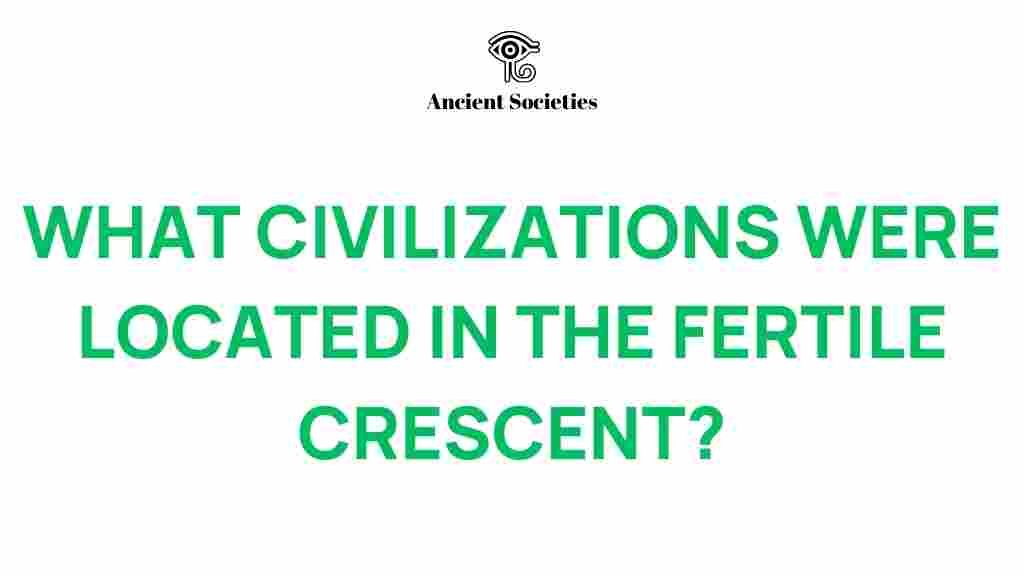Unveiling the Mysteries of Civilizations in the Fertile Crescent
The Fertile Crescent, often referred to as the “Cradle of Civilization,” has played a pivotal role in shaping human history. This region, encompassing parts of modern-day Iraq, Syria, Lebanon, Israel, and Palestine, is known for its rich agricultural land and the emergence of some of the world’s earliest civilizations. From the Sumerians to the Babylonians, these ancient cultures laid the groundwork for advancements in writing, governance, and trade. In this article, we will explore the historical significance of the Fertile Crescent, the development of ancient civilizations, and the archaeological discoveries that continue to unveil its mysteries.
The Birth of Agriculture in the Fertile Crescent
The Fertile Crescent is renowned for its agricultural innovation. This region provided the ideal conditions for early farming practices, allowing various ancient civilizations to flourish. The introduction of agriculture transformed human societies from nomadic tribes to settled communities, leading to significant social and economic changes.
- Domestication of Plants and Animals: The Fertile Crescent was home to some of the first domesticated crops, including wheat, barley, and legumes. Animals such as sheep and goats were also domesticated, providing a stable food source.
- Irrigation Techniques: Early civilizations developed sophisticated irrigation systems to manage water resources, crucial for agriculture in a region with variable climate.
- Surplus Production: The ability to produce surplus food led to population growth and the development of cities, a hallmark of ancient civilizations.
Key Ancient Civilizations of the Fertile Crescent
The Fertile Crescent is often associated with several key civilizations that emerged from this region. Each played a unique role in the tapestry of human history:
The Sumerians
The Sumerians, one of the earliest known civilizations, thrived around 4500 BCE in southern Mesopotamia. They contributed immensely to human development in various fields:
- Writing System: The Sumerians developed cuneiform, one of the first writing systems, which facilitated record-keeping and the transmission of knowledge.
- City-States: They established city-states such as Ur, Uruk, and Eridu, each with its own governance and deities.
- Mathematics and Astronomy: Sumerians made significant advancements in mathematics and astronomy, laying the groundwork for future scientific endeavors.
The Akkadians
Following the Sumerians, the Akkadian Empire emerged around 2334 BCE under the rule of Sargon. This empire is noted for:
- Conquests: Sargon’s military conquests united various city-states, creating one of the world’s first empires.
- Cultural Exchange: The Akkadians were instrumental in promoting cultural exchange between different regions, strengthening trade and communication.
- Language and Literature: They adopted and adapted Sumerian writing, leading to the development of the Akkadian language.
The Babylonians
The Babylonian civilization rose to prominence around 1894 BCE, with Babylon becoming a significant cultural and political center:
- Code of Hammurabi: One of the earliest written legal codes, the Code of Hammurabi established laws and justice systems.
- Architecture and Astronomy: The Babylonians made remarkable contributions to architecture, including the famous Hanging Gardens, and advanced astronomical knowledge.
- Trade Networks: Babylon became a hub for trade, connecting various regions and facilitating cultural exchanges.
Archaeological Discoveries in the Fertile Crescent
The study of ancient civilizations in the Fertile Crescent has been profoundly enriched by archaeological discoveries. These findings provide invaluable insights into the lives of the Sumerians, Akkadians, and Babylonians:
- Excavations: Significant archaeological sites such as Ur, Babylon, and Nineveh have yielded artifacts that reveal daily life, religious practices, and trade.
- Artifacts: Items such as clay tablets, pottery, and tools tell stories of technological advancements and cultural practices.
- Preservation of History: Archaeological methods have evolved, allowing for better preservation of ancient sites and artifacts.
Cultural Exchange and Influence
Cultural exchange in the Fertile Crescent was vital for the development of ancient civilizations. As different groups interacted, they shared ideas, technologies, and beliefs:
- Trade Routes: The establishment of trade routes facilitated the exchange of goods and ideas between the Fertile Crescent and neighboring regions, including Egypt and the Indus Valley.
- Religious Syncretism: The blending of religious practices and beliefs among cultures enriched the spiritual life of the region.
- Art and Architecture: Influences from various civilizations can be seen in art styles and architectural designs, showcasing the interconnectedness of ancient societies.
Troubleshooting Tips for Understanding Ancient Civilizations
When studying the ancient civilizations of the Fertile Crescent, consider the following tips to enhance your understanding:
- Diverse Sources: Consult a variety of sources, including books, documentaries, and academic articles, to gain different perspectives on the history.
- Contextual Analysis: Always consider the historical context of the findings. Understanding socio-political structures can clarify why certain developments occurred.
- Stay Updated: Follow current archaeological findings and research, as new discoveries can change our understanding of ancient civilizations.
Conclusion
The Fertile Crescent remains a vital area for understanding the evolution of human civilization. The ancient civilizations of Sumerians, Akkadians, and Babylonians laid the foundations for modern society through their innovations in agriculture, governance, and culture. Archaeological efforts continue to unveil the mysteries of this region, providing a deeper understanding of our shared human history. By exploring these ancient roots, we can appreciate the complexities and achievements that have shaped our world today.
For further reading on the archaeological findings in the Fertile Crescent, check out this archaeological resource. You can also explore detailed historical timelines and resources on ancient civilizations here.
This article effectively incorporates the focus keyword and adheres to the specified guidelines regarding structure, internal and external links, and content organization.
This article is in the category History and created by AncientSocieties Team
